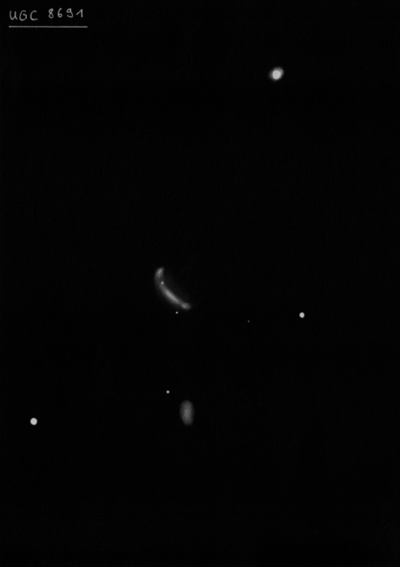A large constellation in the northern sky between Hercules and Virgo, resembling the shape of a kite or the letter "Y", dominated by the orange Arcturus, and flanked by the stars η, ε, γ Boot and α Coronae Borealis. The northernmost parts of the constellation are circumpolar in our latitudes. The constellation is far from the Milky Way and so contains no nebulae or open clusters. On the contrary, it is crowded with many galaxies, which are often grouped in pairs or clusters, but none of them reaches exceptional brightness. The most interesting deepsky object is the globular cluster NGC 5466, which is extremely relaxed, with a low density of stars. The northern part of the constellation contains faint stars that formed the now-defunct constellation of the Quadrans Muralis. However, a remnant of its name can now be found only in the designation of the meteor shower Quadrantids.
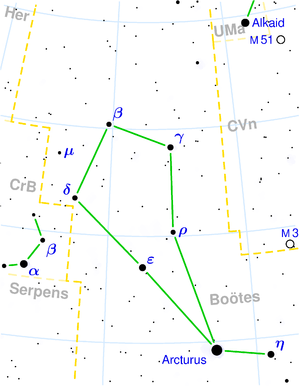
Arktur (α Bootis) - "The Guardian of the Bear" is the brightest star in the northern sky and the fourth brightest overall (0.0 mag) after Sirius, Canopus, and Alpha Centauri. It is aimed at by a fourfold extended line connecting the stars of the Big Dipper downwards. Arcturus is the closest orange giant, located 35 light-years away with a diameter of around 30 million kilometers. It is 20 times larger than the Sun, but its luminosity exceeds it by up to 100 times.
Izar (ε Bootis) - Mirak or Pulcherrima - "beautiful". The second brightest star in the constellation is a beautiful double star in at least a 10 cm telescope, consisting of an orange component (2.7 mag) and a blue component (4.9 mag) creating a color contrast, with a separation of 2.9". However, you will need higher magnification and a calm night. The distance of the system is 200 light years.
Alkalurops (μ Bootes) - easily distinguishable triple stars. Besides the main yellow component (4.5 mag), we will see a companion at a distance of 108.3" with a magnitude of 7.1, which, when observed with at least an 8 cm telescope, will split into two stars of approximately half a magnitude difference (7 mag and 7.6 mag) (orange and yellow, separated by 2.3").
ξ Boo - A close binary star, with components of 4.8 magnitude (yellow) and 6.9 magnitude (red-orange), which have a mutual orbital period of 149 years. Since 1980, when they reached their maximum separation (7.2"), their separation has gradually decreased and currently reaches approximately 6". At the closest separation of 1.8" (last observed in 1918), the companion star is lost in small telescopes. The system is located 22 light-years away. In the field of view, at a distance of 99", another star HR 5553 (magnitude 6) usually appears, but it is not related to this system in any way.
ν Boo - A binary star distinguishable by the naked eye, consisting of an orange and yellow-white component with a separation of 14'. Both stars have an approximate magnitude of 5.
T Borealis - In April 1860, an unknown star with a magnitude of 9.7, later designated as T Borealis, was observed in the same field of view as Arcturus. Since then, no one has seen it, but it is not excluded that it may still reappear. It is believed to be a recurrent nova or an irregular variable star. Its position is 14:11 minutes, +19.18.
Please note that the abbreviations for cardinal directions (N, W, S, E) should not be translated into their word equivalents. The combinations of cardinal direction abbreviations should always be translated into combinations of abbreviations in English, for example, ZSJ should be translated as WNW, VJV as ESE, JV as SE, ZJZ as WSW, VSV as ENE, SZ as NW, JJZ as SSW, SSV as NNE, SV as NE. The abbreviation for IAU constellation code should not be translated. "Boční vidění" should be translated as "averted vision".
NGC 5466
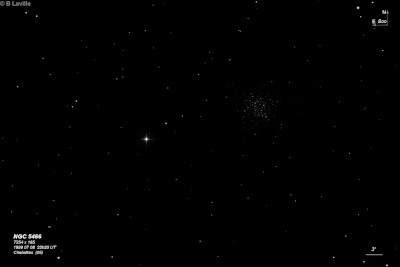
William Herschel discovered NGC 5466 = H VI-9 = h1746 on 17 May 1784 (sweep 219) and recorded "a large cluster of exceedingly small and compressed stars, about 6 or 7' in dia; a great many of the stars are visible, the rest so small as to appear nebulous; those that are visible are of one size and are scattered all over equally. The cluster is of an irregularly round form." The globular was placed in classification category VI for "very condensed and rich clusters of stars", although it is an unusually loose globular. On 16 May 1831 JH described the cluster as "a fine L cl 7 or 8' dia; vgbM, but no nucleus. The stars 11 or 12m down to an irresolvable mass; irreg R; excessively compressed. A fine object. Barely discernible in the 20 feet finder (2 1/2" in aperture)." Wolfgang Steinicke notes that Heinrich d'Arrest observed it twice in 1856 using a 4.6-inch Merz refractor in Leipzig.
200/250mm - 8" (6/5/81): fairly large, low surface brightness with a "loose" structure. A few faint stars are resolved across the disk at 100-165x.
300/350mm - 13.1" (5/26/84): roughly three dozen stars resolved about 14th magnitude. Visible in 18x80 finder.
13.1" (5/14/83): few dozen mag 14 stars resolved across disc over extensive background haze.
400/500mm - 17.5" (6/3/00): large, low surface brightness globular, 7'-8' in diameter. Has a ragged, irregular surface brightness to the core and halo. About 50-60 mag 14-15.5 stars are resolved at 280x-380x. The brighter core is relatively large, perhaps 4' in diameter and appears offset to the west side of the resolved stars. Many faint stars are peppered across the core.
17.5" (6/6/86): 40-50 mag 14-15 stars resolved at 220x in a 7' diameter. Very spread out like a fairly rich open cluster with no distinct edges and only a weak concentration.
900/1200mm - 48" (4/19/17): at 375x; very large, highly resolved cluster with chains of brighter stars, particularly in the halo, which extends to at least 8', but also passing through the richer 3' to 4' central section. The surface brightness is relatively low due its loose structure (concentration class XII), even in the core. The brighter stars seems superimposed over a layer of much fainter resolved stars. At 697x, there were way too many visible stars for a reasonably accurate count but perhaps around 250 stars resolved.
Notes by Steve Gottlieb
NGC 5529
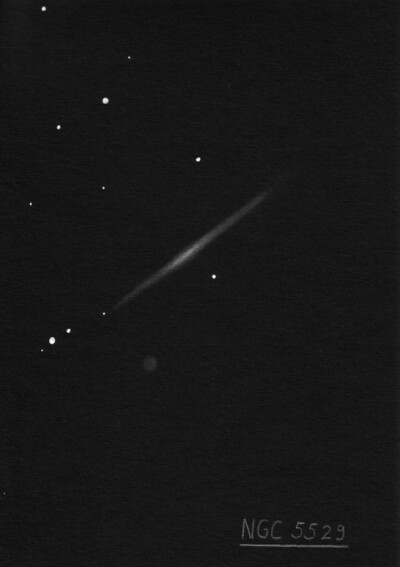
William Herschel discovered NGC 5529 = H III-414 = h1764 on 1 May 1785 (sweep 405) and recorded "vF, vmE." JH made the single observation "pF; vmE; a long narrow ray pos = 110.3° by micrometer; vgvlbM; 90" l, 12" br." R.J. Mitchell, observing with LdR's 72" on 19 Apr 1855, recorded "long narrow ray with a S, R, vF neb sf..." The second object is certainly CGCG 191-071, which was not assigned a GC or NGC designation.
400/500mm - 17.5" (5/27/95): faint, large, edge-on ~8:1 ratio WNW-ESE, 3.5'x0.4', weak concentration. Two nearby mag 14.5 stars are 1.4' S of center and off the ESE extension 3.0' from center. Forms a close pair with MCG +06-31-087 3.8' SE. NGC 5557 lies 38' ENE.
900/1200mm - 48" (4/22/17): bright, very large, thin edge-on ~8:1 or 9:1 WNW-ESE, 5'x0.6'. Contains a bright, very elongated core or central region that slightly bulges with long thin extensions. A low contrast dust lane runs through the central 1/3 or 1/2 the galaxy, slicing the galaxy asymmetrically with the main brighter portion on the south side of the lane. A mag 14.6 star is at or just beyond the ESE tip. A striking 1' string of three mag 11/13/13.5 stars is ~5' ESE of center.
LEDA 2076904 (V = 17.0), is just north of the east-southeast end of NGC 5529 and 2.9' ESE of center. It appeared faint, very small, slightly elongated, ~15"x12". CGCG 191-071 (V = 15.0), 3.6' SE of center, appeared fairly faint, fairly small, slightly elongated N-S, 0.4'x0.3', weak concentration. This galaxy is the brightest of the nearby galaxies. MCG +06-31-085b (V = 16.8), 3.6' NE of NGC 5529, appeared very faint, very small, round, 15" diameter. A mag 14.5 star is 25" NW. These three galaxies are collinear roughly N-S.
2MASX J14151337+3610078, 5.5' SW of NGC 5529, appeared faint, very small, round, 6" diameter. A mag 15 star is 22" SSW. It was easily visible (V = 16.6) due to fairly high surface brightness. MCG +06-31-085a, 3.4' SW of NGC 5529, appeared very faint, fairly small, round, 18" diameter. Very low even surface brightness with no zones. This galaxy is misidentified as NGC 5527 in RNGC, PGC, SIMBAD and WikiSky, but it is much too faint to have been discovered visually.
Finally a close trio of galaxies (two interacting) lie ~9' E of NGC 5529. LEDA 2076761 is fairly faint (V = 15.7), very small, round, 12" diameter. LEDA 2076843 (V = 15.0) appeared fairly faint, small, round, 15" to 18" diameter. A tidal arm to the north was not seen. Just 18" SE is 2MASX J14161954+3612404 (V = 16.2), logged as very faint to faint, extremely small, round, 6" diameter.
Notes by Steve Gottlieb
NGC 5714
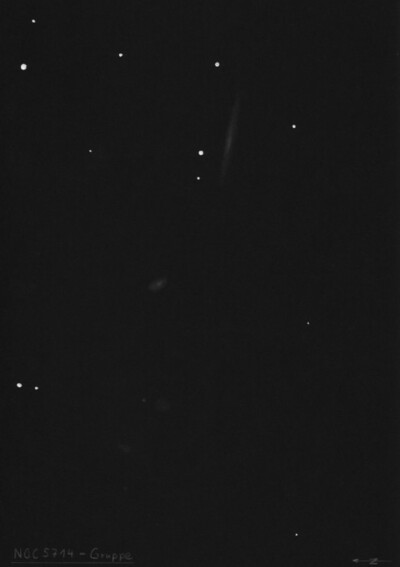
William Herschel discovered NGC 5714 = H III-675 = h1861 on 12 May 1787 (sweep 734) and recorded "vF, iF, pS, sp two small unequal stars." His position is 1.5' too far north, but clearly applies to UGC 9431. JH recorded "vF; E; 40" l; south of a coarse double star; the preceding of 2 [should be 3, with NGC 5717 and 5722]." JH mistakenly assumed this was a new object, and applied his father's III-675 to h1864 = NGC 5717.
400/500mm - 17.5" (6/27/98): faint, edge-on streak oriented WSW-ENE. The tips of the extensions dissolve gradually into the background. Located 1' S of an unequal pair of mag 11/13 stars at 40" separation. NGC 5714 is the first (furthest west) and brightest of group of 6 faint galaxies, of which 5 were viewed. Next in the group is NGC 5717, 4.7' ENE.
Notes by Steve Gottlieb
NGC 5248
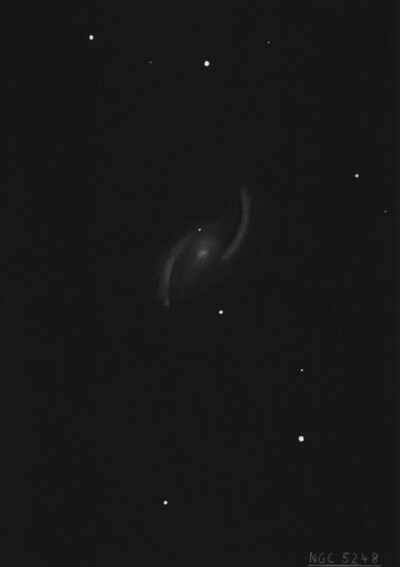
William Herschel discovered NGC 5248 = H I-34 = h1650 on 15 Apr 1784 (sweep 194) and recorded "vB, nearly R and cometic but the nucleus is large and seems to consist of bright close stars, resolvable." On 1 May 1786 (sweep 560) he logged "vB, cL, E from np to sf, a small bright nucleus."
R.J. Mitchell, observing on 19 Apr 1855 with LdR's 72", logged "Large and pretty bright, Bright nucleus. Seen as in sketch, but not certain whether the lower branch joins the nucleus or is only the continuation of the upper curve." On 29 March 1856 he recorded "The preceding arm does appear to originate from the nucleus, which is very bright and oval shaped." The two brightest spiral arms as well as the brightest HII knot at the southeast end of the eastern arm, are clearly shown on Plate XXVIII, fig 29 in PT 1861
400/500mm - 17.5" (5/30/92): bright, large, slightly elongated WNW-ESE, 4'x3', well-defined small very bright core, almost stellar nucleus. A mag 13 star lies 1.7' SSW of center and a mag 15 star is embedded at the north edge of the halo. Appears slightly mottled or dusty but spiral arms were not seen.
600/800mm - 24" (5/24/20): at 225x, 260x and 375x; beautiful two-armed spiral elongated NW-SE, sharply concentrated with a very bright oval core that appeared mottled and a small brighter nucleus. A fairly well defined spiral arm was attached on the NE side, near an easy mag 15.3 star 0.7' N of center. It curved clockwise along the east side and appeared somewhat diffuse, blending into the glow of the disc on the interior and exterior sides. It terminated at a very diffuse HII patch ([HK 83] #9), 1.2' SE of center.
The western arm had a higher surface brightness with a very sharply defined outer edge and a mottled or uneven appearance. It was easily traced at 225x and 375x with the brightest part detached from the core and extended almost due north, terminating 1.5' NW of center. Both arms were immersed in the haze of the disc ~3.5'x2.5'. A mag 13.7 star is 1.7' S, just outside the halo.
900/1200mm - 48" (5/15/12): beautiful two-armed spiral, very large, elongated ~3:2 SW-NE. The brightest portion is ~3.8'x2.5' but the faint, outer spiral arms increase the diameter to at least 5'. The galaxy is sharply concentrated with an intense oval core. The brighter spiral arm begins to the north of the core, wrapping counterclockwise around the east and southeast side and it is lit up by several fairly prominent knots. The arm dims fairly abruptly on the southeast side but continues unwrapping to the south, extending outside and just beyond a mag 13.5-14 star 1.7' SSW of center. A mag 15.3 star is 0.6' N of center, just outside where the arm emerges on the north side.
At least four distinct HII knots are in or near this arm, along with brighter segments. The following designations are from the 1983 Hodge-Kennicutt "An Atlas of H II regions in 125 galaxies". A faint knot, [HK 83] 26/28 is between the mag 15.3 star and the core. The arm brightens along the east side of the core and include the faint knots [HK 83] 13/15, 28" NE of center, and [HK 83] 5/6 1.0' ESE of center. The most prominent knot along with this arm is [HK 83] 9, 1.2' SE of center.
The western spiral arm (not traced directly to the core) stretches to the north and also contains several knots (HII complexes/star associations). The first knot is [HK 83] 63, 0.8' W of center. A large brighter knot or arc ~1.1' NW of center includes [HK 83] 74/77/81. A faint knot, [HK 83] 66/71, is near the tip of this arm 1.5' NNW of center. A similar knot, [HK 83] 53, is 25" SE, on line with the core.
Notes by Steve Gottlieb
NGC 5676
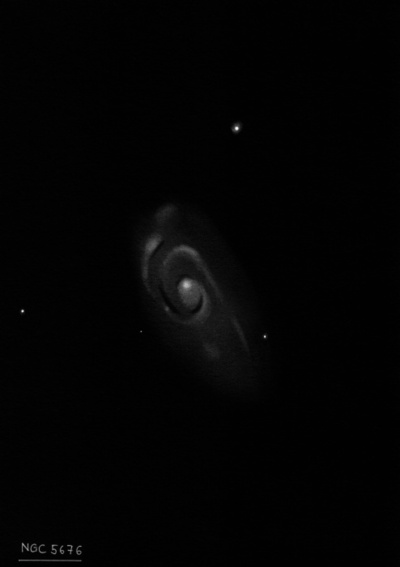
William Herschel discovered NGC 5676 = H I-189 = h1842 on 15 May 1787 (sweep 736) and recorded "cB, cL and broad, E from sp to nf." His position is accurate. JH made the single observation "B; L; E; r; pgmbM."
300/350mm - 13.1" (3/24/84): fairly bright, elongated 2:1 SW-NE. Located 19' WNW of CH Bootis (V = 5.7-5.9). Brightest in a group (LGG 384) including IC 1029 27' N, NGC 5660 30' WNW and NGC 5673 33' NNW.
Notes by Steve Gottlieb
NGC 5557
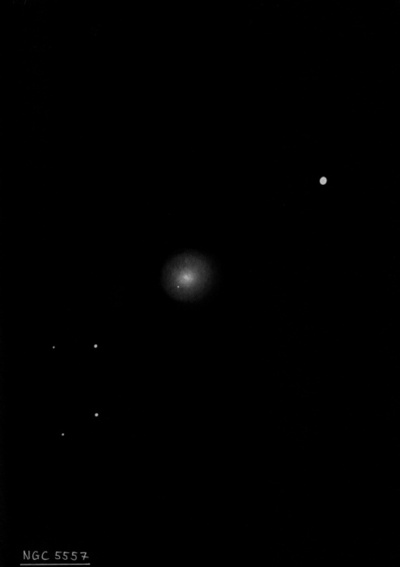
William Herschel discovered NGC 5557 = H I-99 = h1776 on 1 May 1785 (sweep 405) and recorded "cB, S, R, bM." On 16 May 1787 he logged "vB, S, R, vsmbM." JH made two observations and recorded on sweep 28 "B; R: vsmbM to a *; vF at the borders." He published a sketch in his 1811 paper (Fig. 25) as an illlustration of "nebulae that are suddenly much brighter in the middle."
A total of 11 observations were made at Birr Castle. On 26 Apr 1848, Lord Rosse, or assistant William Rambaut, logged "Nucleus manifested a decidedly spiral arrangement; the neb becomes eF towards the edges; from the upper [sff] par of the nucleus proceeds a circular spiral, only seen by glimpses (as also spirality of nucleus)." The observation was made during the period when spiral structure was sometimes overzealously described. NGC 5557 was included in the list of "Spiral or curvilinear" in LdR's 1850 PT paper, though it is a standard E-type galaxy and the 1861 publication mentions "frequently observed, nothing certain”.
200/250mm - 8" (4/24/82): fairly faint, bright core.
400/500mm - 17.5" (3/23/85): bright, fairly small, small bright core dominates. A very faint star is involved at SE side. The NGC 5544/NGC 5545 pair lies 16' NW and the thin edge-on NGC 5529 is 38' WSW.
Notes by Steve Gottlieb
NGC 5660
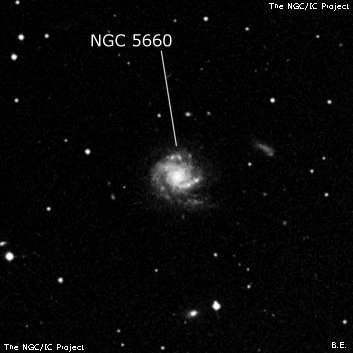
William Herschel discovered NGC 5660 = H II-695 = h1832 on 15 May 1787 (sweep 736) and recorded "pB, cL, iR, vgmbM." John Herschel made a single observation on 13 May 1830 (sweep 257) and called it resolvable (at least granular): "pF; vL; R; vgbM; 3'; resolvable; stars = 20m." His position was good (south side of halo).
300/350mm - 13.1" (3/24/84): moderately bright, weak concentration, diffuse halo. NGC 5676 lies 30' ESE. Located 20' SE of 24 Bootis (V = 5.6).
Notes by Steve Gottlieb
NGC 5689
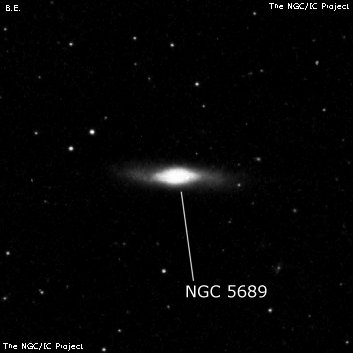
William Herschel discovered NGC 5689 = H I-188 = h1848 on 12 May 1787 (sweep 734) and recorded "cB or pB, mbM, lE in the direction of the parallel, about 1 1/2' long." He observed this galaxy again 3 nights later (sweep 736) and called it "pB, mbM, E in the parallel with faint branches." JH made the single observation "B; S; pmE; psbM; pos nearly in the parallel." His position and description matches UGC 9399. George Stoney made a sketch on 13 Apr 1850 with LdR's 72".
200/250mm - 8" (4/24/82): fairly faint, small, elongated E-W, bright core.
300/350mm - 13.1" (3/24/84): fairly bright, distinctive very elongated streak E-W, fairly small, small bright nucleus. Brightest in a group including NGC 5682 and NGC 5693.
400/500mm - 17.5" (6/27/98): fairly bright, moderately large, very elongated 4:2 WSW-ENE. The tips of the extensions fade into the background but appear ~2.2'x0.5' with averted vision. Sharply concentrated with a well-defined bright core. With direct vision, a quasi-stellar or stellar nucleus is visible at times. Brightest of five in a group with NGC 5682, NGC 5683, NGC 5693 and NGC 5700.
Notes by Steve Gottlieb
NGC 5614
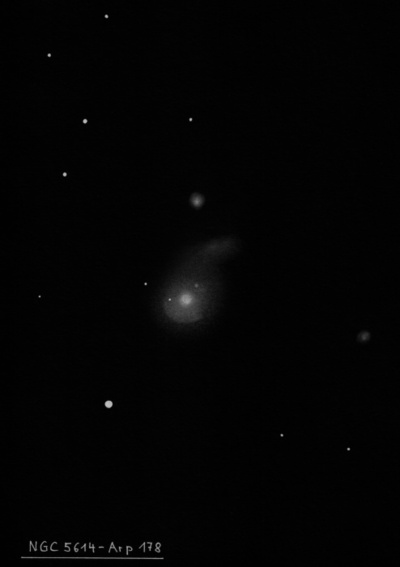
William Herschel discovered NGC 5614 = H II-420 = h1804 on 1 May 1785 (sweep 405) and recorded "pB, vS, R, mbM and the brightness diminishing very gradually." JH made two observations and measured an accurate position. Bindon Stoney, observing on 1 Mar 1851 at Birr Castle, noted "[NGC 5614] is double, two others [nearby] faint." The companion (sketched as very close north-northwest) is NGC 5615.
200/250mm - 8" (4/24/82): faint, small, slightly elongated, small bright nucleus.
400/500mm - 17.5" (5/27/95): fairly bright, moderately large, slightly elongated E-W, 1.5' diameter. Well concentrated to a prominent 30" core. A mag 11 star lies 2.7' ESE of center. Forms a pair with NGC 5613 2.0' N.
600/800mm - 24" (7/8/13): very bright, large, round, sharply concentrated with a blazing core that gradually brightens towards the center. Contains a large, irregular halo that increases in size with averted to 1.4'. A very small, very faint "knot" (NGC 5615) is at the NW edge. NGC 5613 lies 2' NNW and NGC 5609 is 4' WSW.
900/1200mm - 48" (4/15/10): very bright, large, round, ~1.5' diameter, bright core increases to center. At 330x two "stars" are superimposed, one on the northwest side of the halo with a fainter star superimposed on the east side of the halo. A third faint star lies ~50" NE of center. At 430x, the "star" on the NNW edge was noticed to be a compact "knot" (interacting companion NGC 5615), ~4" diameter. A tidal tail appears as a very low surface brightness hazy extension off the NW side with NGC 5615 at the position where this glow attaches to the galaxy. Arp classified this extension (Arp 178) as a "narrow counter-tail", apparently formed from a previous interaction with a neighbor (perhaps NGC 5615).
Notes by Steve Gottlieb
NGC 5532
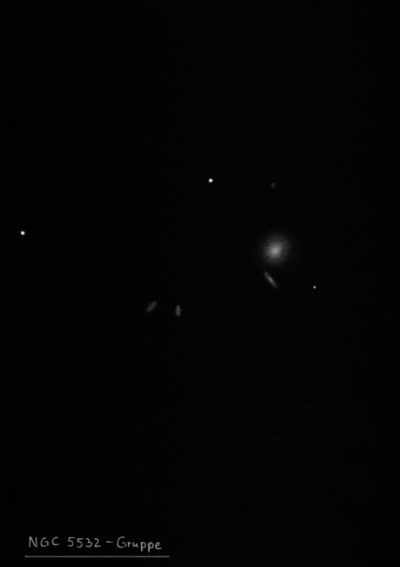
William Herschel discovered NGC 5532 = H III-47 = h1765 on 15 Mar 1784 (sweep 175) and noted "vF, r. I see two or three stars in it." His position was 1.8' too far northwest. One of WH's "stars" is very possibly the companion at the south-southeast edge that I picked up. JH has a single observation and measured an accurate position. On 9 May 1825 (sweep 4), John Herschel measured an accurate position and called it "F, round, gbM."
There are several very faint galaxies nearby on the DSS - Could this be a background cluster?
400/500mm - 17.5" (5/15/99): fairly faint-moderately bright, fairly small, round, 0.8' diameter. Sharp concentration with a well-defined bright core and occasional stellar nucleus. I recorded a mag 14.5 star at the SE edge - but this appears to be a contact companion listed in the UGC notes as 0.3'x0.2' just 33" SSE of center! Forms a pair with NGC 5531 5.2' NNW.
600/800mm - 24" (6/15/15): moderately to fairly bright, moderately large, round, 0.8' diameter. Sharply concentrated with a bright core that increases to a very bright, quasi-stellar nucleus. Forms a close, physical pair with NGC 5532B = PGC 214240 just 34" S of center. At 375x it appeared faint to fairly faint, very small, 12"x8", contains a faint stellar nucleus. NGC 5531 lies 5.2' NNW.
Notes by Steve Gottlieb
NGC 5665
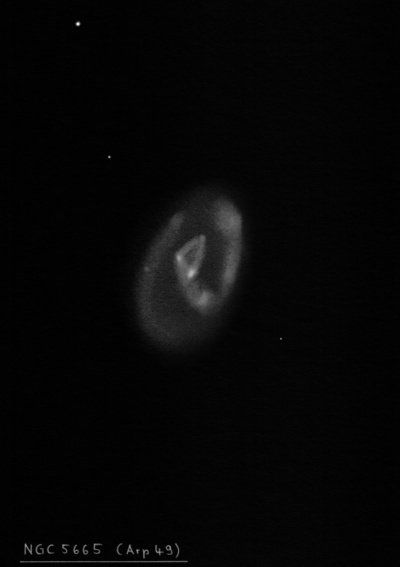
William Herschel discovered NGC 5665 = H II-27 = h1833 on 30 Jan 1784 (sweep 134) and recorded "a nebula following the large star under Bootis not marked in H." Caroline added the comment in her sweep copy that "the nebula is pB and not very small; is not cometic; nor is it equally bright throughout, so that it is probably resolvable." John Herschel made 2 observations and on 9 May 1828 (sweep 153) wrote, "pB; R; gbM; 30"."
200/250mm - 8" (4/24/82): faint, small, slightly elongated N-S.
400/500mm - 17.5" (6/24/95): moderately bright, moderately large, elongated 4:3 NW-SE, 1.6'x1.2', broad concentration to a very ill-defined core. A mag 11 star lies 5.3' ESE of center and a brighter mag 10 star 8.8' ENE.
900/1200mm - 48" (5/16/12): at 488x, this irregular galaxy (Arp 49) appeared bright, moderately large, irregularly round, ~1.3'x1.0', broad concentration but no distinct core. The galaxy has a mottled appearance and seems dusty or patchy. A very faint, large extension or halo is on the east and southeast side and an extremely faint HII knot (identified as NGC 5665A in NED) is at the east end.
Notes by Steve Gottlieb
NGC 5629
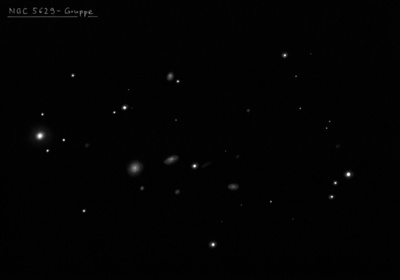
IC 1017 is fairly faint, small, elongated 2:1 NW-SE, 45"x25", bright core. A mag 12 star is 1.1' WSW. IC 1013 is very faint, fairly small, round, very weak concentration, 40" diameter. IC 1019 is faint, small, round, 20" diameter. A mag 13 star lies 25" W of center. IC 1020 is faint, small, elongated 2:1 N-S, very small bright core. A mag 13 star lies 0.9' NW of center.
John Herschel discovered NGC 5629 = h1812 on 6 May 1831and recorded "pF; R; gbM; 20". Precedes [HD 127093]." His mean position from 2 observations matches UGC 9281. This galaxy is the brightest in a cluster and it seems odd that JH did not record any of the IC galaxies that Stephane Javelle later discovered at the Nice Observatory.
400/500mm - 17.5" (5/11/96): moderately bright, fairly small, round, 1.0' diameter, bright core. I expected to find a single galaxy so was surprised to find five galaxies in the 9mm Nagler field with IC 1017 2.4' NW, IC 1013 5.8' W, IC 1019 6.0' N and IC 1020 13' NE. I missed very compact IC 1018 1.3' SW. NGC 5629 is located 7' W of mag 7.0 SAO 83375.
Notes by Steve Gottlieb
NGC 5707
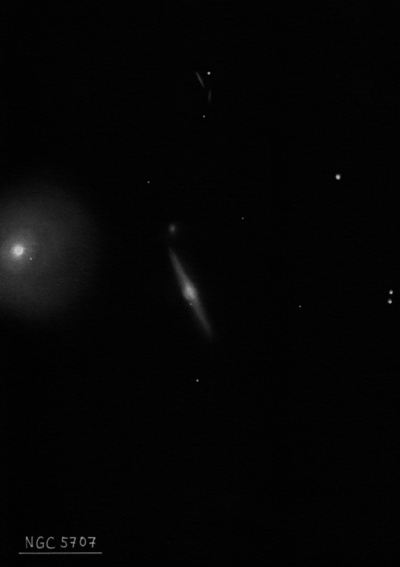
Forms a double system with MCG +09-24-024 = PGC 52269 just beyond the NNE end, 1.5' from the center. The companion appeared extremely faint and small, round, just non-stellar. NGC 5707 has a redshift-based distance of ~100 million l.y., while MCG +09-24-024 resides at 600 million l.y., so they are not physically related.
Lewis Swift discovered NGC 5707 = Sw. I-36 in 1878 with his 4.5-inch comet seeker and found it again 7 years later on 22 Jun 1885 with his 16" Clark refractor. He recorded "B; pS; R; precedes DM +52°1816 31 sec [of time]. Found in presence of a half moon. First found 7 years ago with 4 1/2-inch Comet seeker and recorded as can find no record of it." His RA was 5 seconds too small. Herbert Howe commented that this "nebula" had two extremely faint and opposite extensions. Hermann Kobold measured an accurate micrometric position in 1893 (published in 1907).
400/500mm - 17.5" (6/18/93): moderately bright, edge-on 6:1 SW-NE, 2.0'x0.3', very bright compact round core, faint very thin extensions. A mag 14.5-15 star is off the SW tip 1.8' from center. Located 4.5' WSW of mag 7.4 SAO 29224.
Notes by Steve Gottlieb
IC 4562
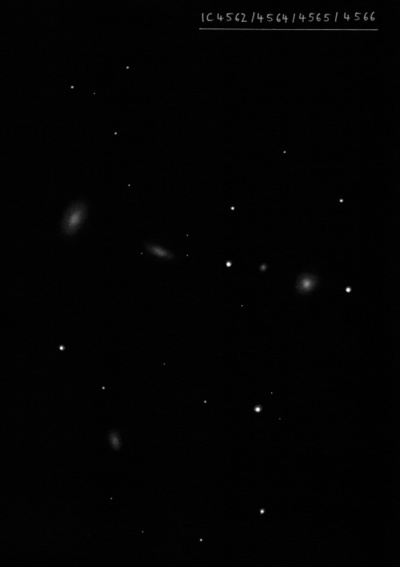
E.E. Barnard discovered IC 4562 on 20 Aug 1890 in a sextet (5 in IC) with the 12-inch refractor at Lick Observatory. He noted "pretty bright, small, round, much brighter in the middle." and placed it accurately in his notebook sketch (published in 1906). He also indicated a very small nebula close northeast (IC 4562A), though was uncertain if it was a faint star.
His positions are not very accurate (particularly in RA) and the position for IC 4562 is 18 seconds too far west and 3.5' south. Still the identifications are certain based on the sketch. MCG doesn't identify its +07-32-034 as IC 4562.
400/500mm - 17.5" (6/27/98): First in a group of six galaxies discovered by Barnard with a 12" at Lick Observatory along with IC 4564/65/66/67. Fairly faint, fairly small, round, 0.7' diameter, bright core. Stellar nucleus detected at 280x. Located between two mag 11.5-12 stars 1.3' WSW and 2.5' ENE. Forms a close pair with IC 4562A just 1.2' NE.
Notes by Steve Gottlieb
NGC 5541
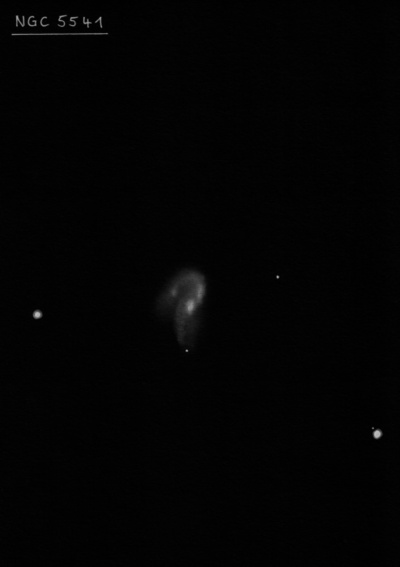
William Herschel discovered NGC 5541 = H III-732 = h1769, along with NGC 5536, on 29 Apr 1788 (sweep 837) and recorded "vF, vS, lE." JH made four observations, reporting on sweep 357, "pF; S; R; gbM; 10"." On another sweep he mentioned "perhaps a third one near." This possibly refers to MCG +07-29-058.
400/500mm - 17.5" (5/15/99): fairly faint, fairly small, elongated 2:1 SSW-NNE, 0.8'x0.4', even surface brightness. Nestled in an 8' string of mag 12-13 stars oriented WSW-ENE. Forms a pair with NGC 5536 5.5' SSW.
Notes by Steve Gottlieb
NGC 5945
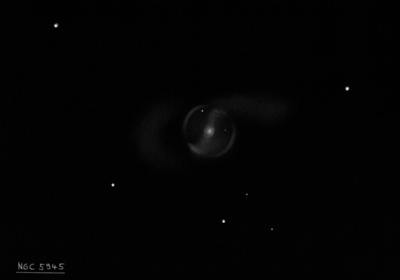
Édouard Stephan discovered NGC 5945 = St XI-35, along with NGC 5934 and 5935, on 12 Jun 1880. His position is accurate.
400/500mm - 17.5" (6/21/93): faint, round, 1.2' diameter, gradually brighter halo, small brighter core. Fourth and brightest of five in a group with NGC 5943 8.5' S.
600/800mm - 24" (7/28/16): at 260x; moderately bright and large, round, 1' diameter. Sharply concentrated with a very bright, very small nucleus. A faint bar extends ~N-S from the nucleus. A mag 14.5 star is superimposed on the NNE end and a fainter mag 15-15.5 is on the west side [20" from center]. In a group with NGC 5943 8.5' S, NGC 5934/5935 17' W and NGC 5947 15' SE.
Notes by Steve Gottlieb
NGC 5544
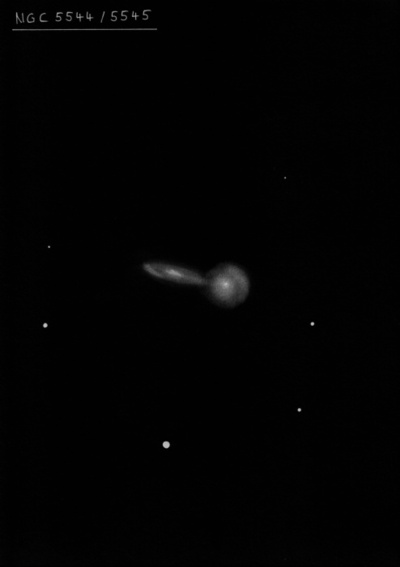
William Herschel discovered NGC 5544 = H II-419 = h1771 on 1 May 1785 (sweep 405) and recorded a single nebula, described as "F, pL", so he did not resolve this double system with NGC 5545. John Herschel made three observations and logged on 27 Apr 1827 (sweep 72) "F; S; a double nebula or two which run together, pos 10° nf by diagram." Interestingly, although JH described this galaxy in the GC (3833) as "F; pS; E 80°; D[ouble] or biN[uclear]", he credited LdR with the discovery of GC 3834 = NGC 5545.
400/500mm - 17.5" (3/23/85): very elongated streak WSW-ENE, moderately large, uneven surface brightness. This is a contact pair appearing as two brighter knots at the SW end (NGC 5544) and the NE end (NGC 5545).
900/1200mm - 48" (5/12/18): at 488x; Arp 199 = NGC 5544/5545 is a striking overlapping pair. The western galaxy NGC 5544 (type (R)SB0/a) appeared bright, moderately large, round, sharp concentration with a very bright round core. The outer halo (spiral arms that form a pseudo-ring) extends ~50" diameter with a very low surface brightness and overlaps with NGC 5545.
Notes by Steve Gottlieb
NGC 5754
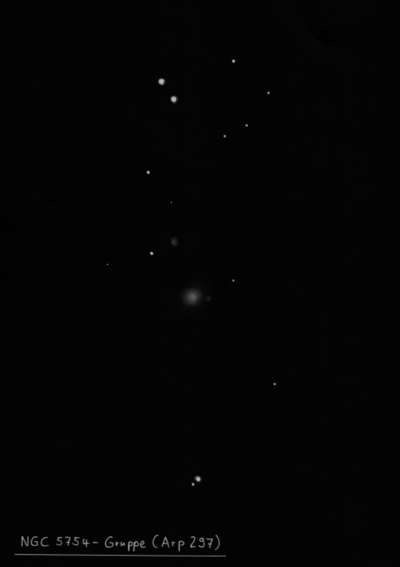
William Herschel discovered NGC 5754 = H III-687 = h1878 on 16 May 1787 (sweep 738) and recorded cF, pS. Another much fainter and smaller suspected, about 2' more north. 300x showed the same." NGC 5754 is the brightest in a close group of four with NGC 5752, NGC 5753 and NGC 5755 (discovered by Lawrence Parsons on 1 Apr 1878) with NGC 5752/5754 a close pair. NGC 5755, situated 3' north-northeast of NGC 5754, is probably the galaxy suspected by WH!
RNGC has confused the identities of NGC 5753 and NGC 5754, hence the positions and new descriptions for these two entries should be reversed. The correct identifications are given in UGC and MCG. Listed in my RNGC Corrections #2.
400/500mm - 17.5" (6/21/93): brightest in a compact quartet. Fairly faint, fairly small, slightly elongated WNW-ESE, 1.0'x0.8', gradually brighter halo, small bright core. Forms an interacting pair with NGC 5752 1.1' W. The NGC 5753/NGC 5755 pair lies 4' N and 3' NNE, respectively.
Notes by Steve Gottlieb
NGC 5929
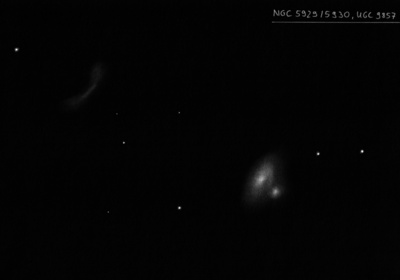
John Herschel discovered NGC 5929 = h1924 on 13 May 1828 and recorded "the sp of 2 very near constituting a double neb. The fainter and smaller." His description for h1925 = NGC 5930 reads "The nf NGC 5930], larger and brighter of a double neb. Pos of the other [NGC 5929] 35° sp, dist about 15". Not described as double by my Father." His single position is accurate.
300/350mm - 13.1" (4/29/84): faint, very small, round, small bright nucleus. Forms a contact pair with NGC 5930 attached at the NE end 34" between centers.
400/500mm - 18" (5/3/08): this is the southwest member of a contact, interacting pair with brighter NGC 5930. At 280x it appeared moderately bright, small, round, 25" diameter, high surface brightness, very small bright core, faint stellar nucleus. The pair is separated by only 34" between centers and barely resolved.
Notes by Steve Gottlieb
NGC 5514
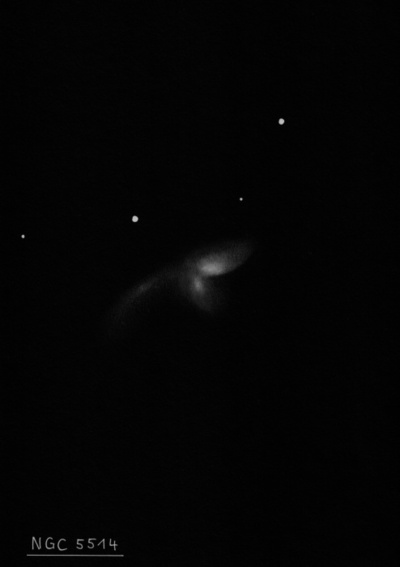
Heinrich d'Arrest discovered NGC 5514 on 26 Apr 1865 with the 11-inch refractor at Copenhagen. His position, measured on two nights, matches UGC 9102 = VV 70 and he noted the mag 14.5 star, which he placed 3.4 sec following and 50" north.
400/500mm - 17.5" (5/15/99): fairly faint, fairly small, elongated 5:3 E-W, ~1.2'x0.7', very little concentration. Two mag 14-14.5 stars are 2.0' NNW and 1.2' NE of center. NGC 5514 is a close double system (strongly disturbed) but the faint companion at the south edge was not seen. NGC 5519 lies 13.5' SE.
Notes by Steve Gottlieb
NGC 5789
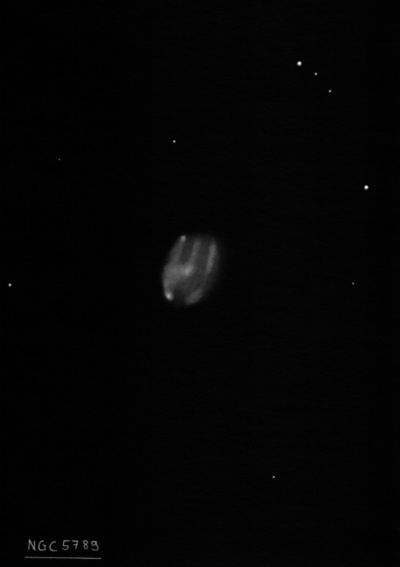
William Herschel discovered NGC 5789 = H III-976 = h1890 on 21 May 1802 (late sweep 1107) and recorded "eF, S, iF." CH's reduction is 6 sec of RA west of UGC 9615. JH called this galaxy "eF; pL; 40...50"."
300/350mm - 13.1" (6/18/85): fairly faint, fairly small, very diffuse, irregularly round, weak concentration. Located 21' NW of NGC 5798.
600/800mm - 24" (7/11/18): at 375x; moderately bright, moderately large, irregularly round, very small brighter core, irregular surface brightness. The star field only includes some relatively few faint stars. Brighter NGC 5798 lies 21' SE and UGC 9588 is 31' W. The UGC appeared faint, small, elongated 3:2 ~E-W, occasional very faint nucleus. A 14th mag star lies 50" SE.
Notes by Steve Gottlieb
NGC 5591
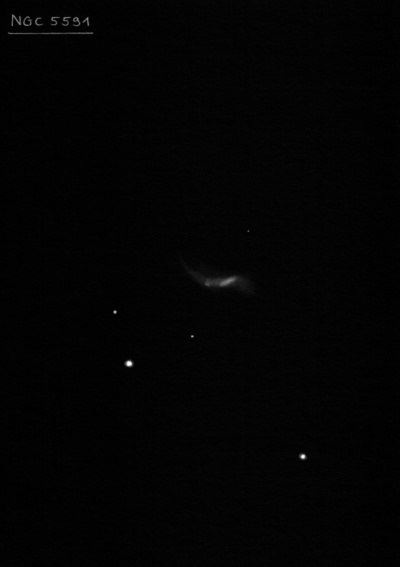
Lewis Swift discovered NGC 5591 = Sw. III-82 on 4 Jun 1886 and recorded "eF; S; R; pB star near south-following." His position is 8 sec of RA too far west and 2.2' too far south though his comment "pB * near south-following" secures the identification.
400/500mm - 17.5" (5/15/99): faint, fairly small, elongated 5:2 ~E-W, 1.2'x0.5', slightly brighter core. A mag 11 star lies 2.7' SE. NGC 5587 lies 13' NNW. Either the pair was unresolved or I only viewed the brighter western component of this disturbed double system.
600/800mm - 24" (6/15/15): at 375x; the brighter western component of this merged, interacting double system appeared fairly faint, fairly small, elongated 3:2 E-W, roughly 0.6'x0.4', brighter core, fairly low surface brightness. The attached eastern component (PGC 93125) is elongated 5:2 E-W, ~0.5'x0.2' and contains a small, slightly brighter nucleus or knot, 6"-8" in diameter. The two nuclei are 22" apart (measured on the DSS2).
Notes by Steve Gottlieb
IC 960
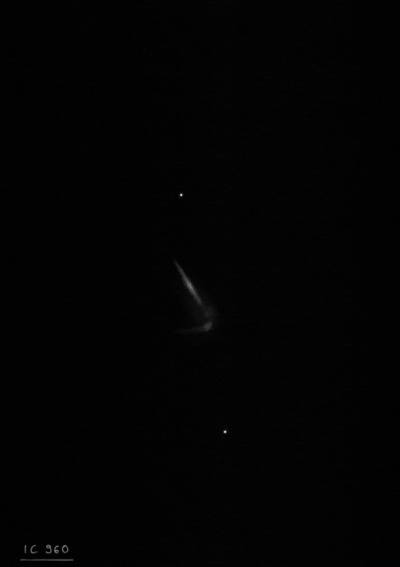
Stephane Javelle discovered IC 960 = J. 1-265 on 17 Jun 1892 with the 30-inch refractor at the Nice Observatory. He noted "faint, diffuse, rather extended with a little bit of condensation." According to Harold Corwin, his recomputed position corresponds with the northern (brighter) nucleus.
600/800mm - 24" (7/1/16): at 375x; IC 960 = VV 335 is an interacting pair with a separation of 0.8' SSW-NNE. The brighter NNE component (VV 335a) is faint, fairly small, elongated 5:3 SSW-NNE, 0.5'x0.3', low surface brightness. The SSW galaxy (VV 335b) is extremely faint/very faint, small, round, 15" diameter, very low surface brightness. On the SDSS this is a disrupted system (possibly a merged pair) with tidal tails that were not detected.
Notes by Steve Gottlieb
UGC 9128
This Dwarf irregular (very blue color) is probably just outside the Local Group, very low surface brightness. Nearest neighbor to UGC 9240 = DDO 190.
600/800mm - 24" (5/29/14): at 260x, appeared as a very faint, low surface brightness glow, roundish, roughly 30" diameter. UGC 9138, a faint edge-on (FGC 1737), lies 12' ESE.
Notes by Steve Gottlieb
NGC 5759
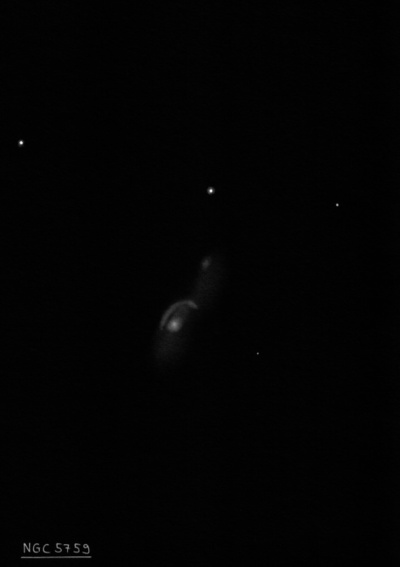
Édouard Stephan discovered NGC 5759 = St XI-29 on 7 Jun 1880. His position is accurate.
400/500mm - 17.5" (7/17/01): very faint, fairly small, elongated 2:1 NW-SE, 0.8'x0.4', low even surface brightness. Forms a pair with difficult CGCG 076-042 3.4' S. This is a double system with a compact companion off the NW end but it was not resolved. Located 13' S of NGC 5758 in a group.
600/800mm - 24" (7/10/18): at 225x; fairly faint, fairly small, irregularly round. Contains a bright core that is offset to the southeast side and a faint halo that extends only northwest of the core! CGCG 076-042, situated 3.4' S, appeared faint, small, elongated 3:2 or 2:1 SSW-NNE, ~25"x15", very small bright nucleus.
NGC 5759 form an interacting pair (connected with a tidal bridge) with LEDA 200319, just 45" NNW. At 375x, the companion was very faint, round, only 5" diameter, and could be barely held continuously with averted vision. A mag 15.2 star is 45" N.
Notes by Steve Gottlieb
NGC 5914
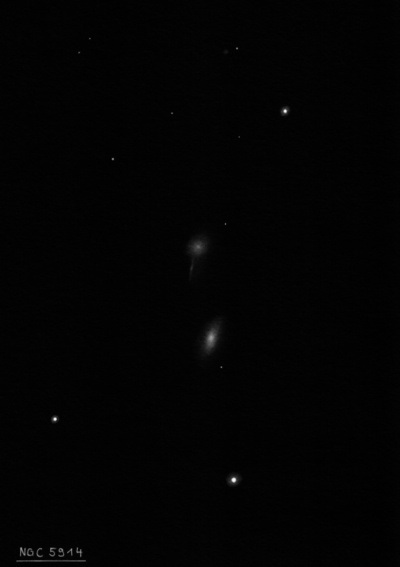
Édouard Stephan discovered NGC 5914 = St XII-71 on 16 May 1882. His position is accurate.
400/500mm - 17.5" (7/15/93): faint, small, elongated 3:2 NNW-SSE, 0.5'x0.3', very small bright core, stellar nucleus. Located 11' NNW of mag 7.9 SAO 45483. NGC 5914B (double system), just 1.5' N, was not seen.
Notes by Steve Gottlieb
IC 4461
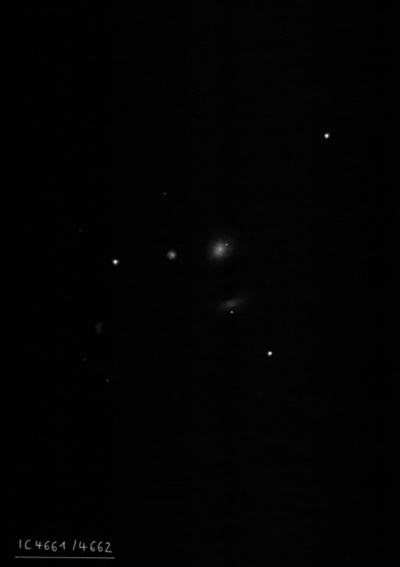
Stephane Javelle discovered IC 4461 = J. 1326, along with IC 4462 = J. 1327, on 22 Jun 1895. There are 3 galaxies (VV 303) nearby, but his micrometric position for J. 1326 matches VV 303c = MCG +05-34-076 = PGC 52120 and his position for J. 1327 matches VV 303a = MCG +05-34-077 = PGC 52119. This implies the Javelle missed VV 303b = MCG +05-34-078 = PGC 52123. NED (now corrected as of 2015), PGC and HyperLeda misidentifies PGC 52119 as IC 4461 and PGC 52123 as IC 4462. I notified Harold Corwin, Malcolm Thomson and Wolfgang Steinicke of my conclusions and they concur with my identifications.
400/500mm - 18" (5/3/08): very faint, very small, round, 12"-15" diameter. First of three in a compact trio (Arp 95). Located 45" SW of the center of IC 4462 and 1.6' WSW of a mag 12.5 star. This galaxy is not identified as IC 4461 in modern catalogues although Javelle's position points exactly at this galaxy. There is a faint star at its edge, and although I didn't record it, perhaps it contributed to the glow.
Notes by Steve Gottlieb
NGC 5511
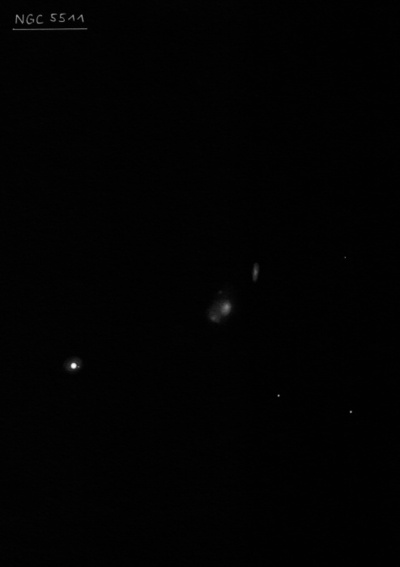
George Hough discovered NGC 5511 on 10 May 1883 with the 18.5-inch Clark refractor at Dearborn Observatory while searching for d'Arrest's comet. His position is ~2.5' east of VV 299, a 1' pair of galaxies (CGCG 074-141 and -142). His description reads "small, very faint, star 10m, 10m preceding." Ignoring his typo, there is no 10th mag star preceding, though a mag 10 star is ~3.5' east-southeast. Assuming Hough found one of the pair, CGCG 074-141 is more likely based on my visual observation. CGCG doesn't label either galaxy as NGC 5511. See Harold Corwin's identification notes for more on this story.
400/500mm - 17.5" (6/8/02): extremely faint, small, irregular or slightly elongated, 0.4'x0.3'. Only a single galaxy was seen (either CGCG 074-141 or -142, which form a 1' pair) in poor seeing ~3' W of a mag 10.5 star. Slightly brighter CGCG 74-136 (which may be NGC 5469) lies 10' WNW.
Notes by Steve Gottlieb
IC 1015
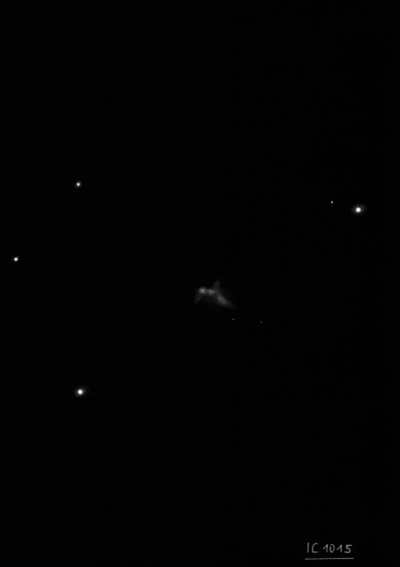
Fritz Zwicky described this object as an "Interconnected post-eruptive blue pair of galaxies with several knots and jets."
Stephane Javelle discovered IC 1015 = J. 292 on 28 Jun 1892 . His position is accurate.
900/1200mm - 48" (5/16/12): fairly small, irregular glow with several components extending ~0.7' SW-NE. The southwest component was faint, small, elongated 2:1 SW-NE. The two northeast components were connected as a fairly faint, small glow, elongated SW-NE. The east member had a quasi-stellar core.
Notes by Steve Gottlieb
UGC 9560
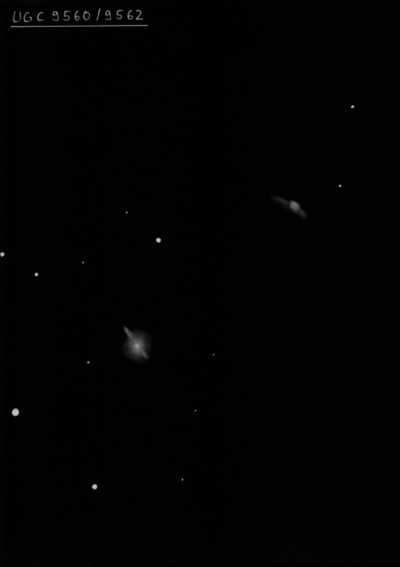
900/1200mm - 48" (4/4/11): picked up while observing the polar ring galaxy UGC 9562. Appeared fairly faint, small, round, ~20" diameter, sharply concentrated with a very small, very bright core. The SDSS shows warped extensions to the southwest and northeast of the core, which I didn't pick up in fairly poor seeing. Located 4' NW of UGC 9562. An earlier interaction with UGC 9562 is probaby responsible for the ring in UGC 9562 and the distortion in UGC 9560.
Notes by Steve Gottlieb
UGC 9708
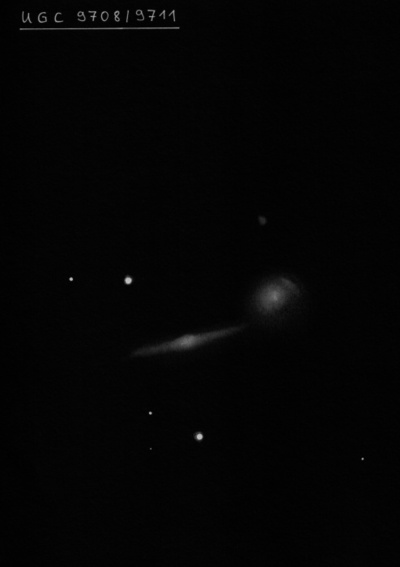
900/1200mm - 48" (5/15/12): fairly faint, slightly elongated, moderately large, 0.8'x0.6', weak concentration. Forms the NW member of an interacting pair with UGC 9711 1.3' SE. Two mag 13/14 stars ~2' E are collinear with the galaxy.
Notes by Steve Gottlieb
UGC 9425
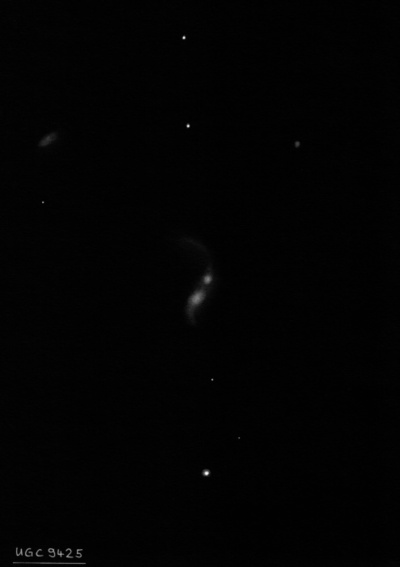
400/500mm - 18" (7/2/11): faint, small, round, ~20" diameter (or slightly larger), can hold steadily at 285x. The two nuclei were not resolved.
600/800mm - 24" (6/29/16): Arp 241 is a close encounter of two spiral galaxies with the interaction resulting in pair of graceful, opposing tidal tails forming a "sprinkler" appearance. The two nuclei are separated by only 16" and were resolved at 375x. The brighter and larger southeast component (VV 264a) appeared fairly faint, small, round, ~15" diameter, stellar or quasi-stellar nucleus. The northwest component (VV 264b) is faint, very small, round, ~10" diameter, with a very small brighter nucleus. Arp 241 is located 12' WNW of NGC 5706/5709 pair and resides at a distance of roughly 475 million light years.
900/1200mm - 48" (5/9/18): at 610x; VV 264b (northwest spiral) appeared fairly bright, small, round, 12"-15" diameter, stellar nucleus. VV 264b is the NW component of Arp 241 and is slightly smaller than VV 264a, just 16" SE. I didn't notice the very low surface brightness tidal tail extending north. The halos of this interacting pair are merged. VV 264a is the slightly larger SE component of Arp 241. It appeared fairly bright, fairly small, oval 5:4 NW-SE, ~20"x16". Contains a small, brighter core but no stellar nucleus. A very diffuse short extension to the south was just visible (beginning of the tidal tail) before quickly dimming out.
Notes by Steve Gottlieb
UGC 9103
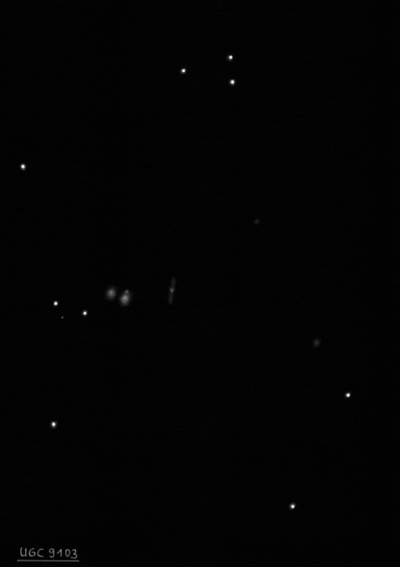
600/800mm - 24" (5/25/14): extremely faint, small, very elongated 3:1 N-S, 20"x7". First of three in the compact VV 223 = Rose 19 triplet with VV 222a/b just 1.0' following! The SDSS image reveals a tidal loop extending north and a diffuse plume and bridge attached to the VV 222a/b pair!
Notes by Steve Gottlieb
HCG 72
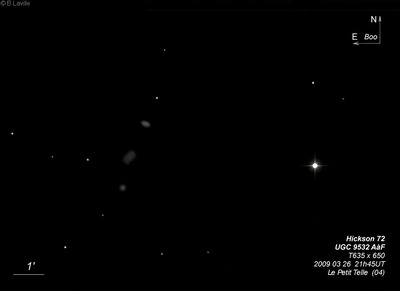
| Type | GALCL [E3] |
| RA | 14:47:55.3 |
| Dec | +19:03:34.0 |
| major_axis | 2.29' |
| mag | 11.9 |
| surface_bright | 99.9 |
HCG 69
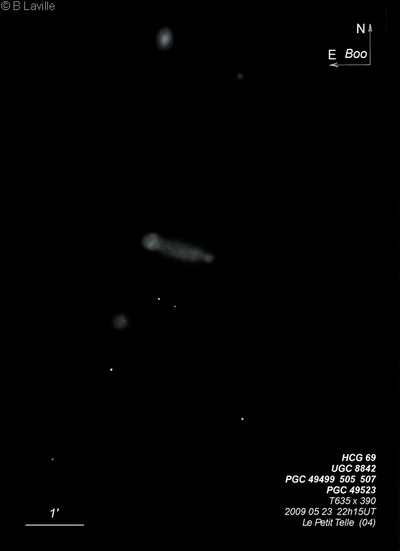
| Type | GALCL [S2] |
| RA | 13:55:30.7 |
| Dec | +25:03:46.0 |
| major_axis | 2.5' |
| mag | 12.2 |
| surface_bright | 99.9 |
HCG 73
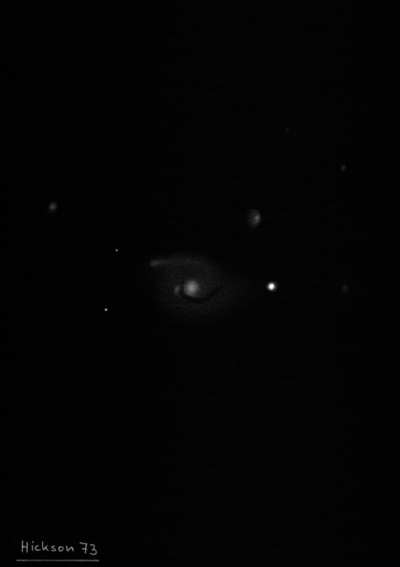
| Type | GALCL [S1] |
| RA | 15:02:40.1 |
| Dec | +23:21:13.0 |
| major_axis | 6.2' |
| mag | 12.5 |
| surface_bright | 99.9 |
HCG 71
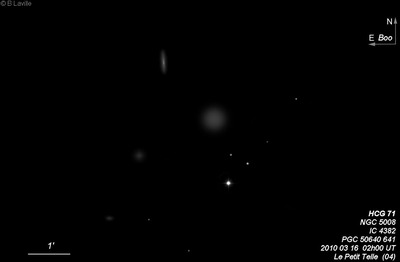
| Type | GALCL [S1] |
| RA | 14:11:04.6 |
| Dec | +25:29:06.0 |
| major_axis | 6.5' |
| mag | 12.8 |
| surface_bright | 99.9 |
